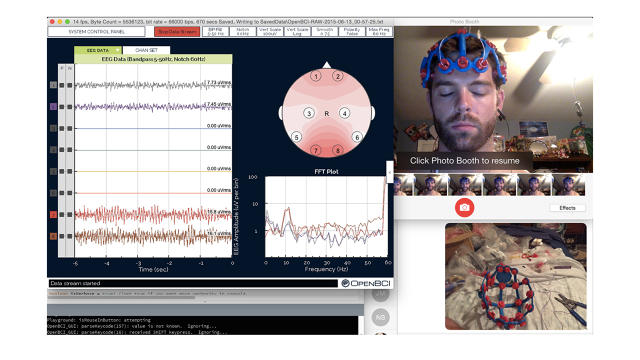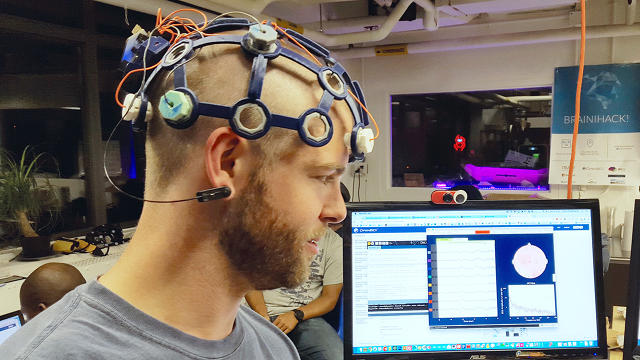New Kickstarter EEG package promises low-cost mind studying
OpenBCI, a undertaking initially funded through DARPA, bargains an EEG headset starting at $449 permitting DIYers to see inside their brains.
November 3, 2015
Sci-fi is full of tales about individuals controlling machines with their minds, but sci-fi is already here, sorta. for instance, previous this yr, throughout the Cognitive technology show off at San Francisco’s Exploratorium science museum, visitors might don electroencephalogram (EEG) headsets that learn brainwave patterns to maneuver a robotic arm. they may also create photography according to their brainwave task. there are various different examples of scientists or just DIY “neurohackers,” jacking in to beginning determining how the electrical energy in their skulls can also be deciphered.
a brand new tool for that, with roots in the U.S. executive’s safeguard advanced analysis initiatives company (DARPA), hit Kickstarter these days, turning in a excessive-end EEG headset kit starting at $449. The Kickstarter goals to lift at least $eighty,000 and ship tools to backers in July 2016.

it’s produced by using a bit Brooklyn startup called OpenBCI (brain-computer interface) created in 2014—no longer by using neuroscientists, however through a tech-focused art professor, Joel Murphy, and his grad student, Conor Russomanno, from ny’s Parsons college of Design. it can be not the first EEG headset to hit Kickstarter, however the creators say that it is completely “open,” which means DIYers can adjust the system and get get entry to to the full raw information coming off the electrodes. It also has the next information-sampling fee than different devices, making it “research-grade,” says Russomanno.
I first met Russomanno in August all the way through the NeuroTechNYC meetup at OpenBCI’s Brooklyn lab. For concerning the first half of hour, I was once carrying what gave the look of a geodesic bicycle helmet. It used to be the third and just-made version of Russomanno’s 3-d-printed Ultracortex headset; and that i scarcely seen the eight sets of metallic pins poking lighting fixtures into my scalp. the entire time, I obtained to peer readouts from more than a few brainwave varieties and from muscle actions in my scalp on a big pc reveal in front of me. This used to be a dry-electrode headset, meaning I did not have to squirt conductive gel onto my scalp. the fact that i have a buzz lower made it especially easy (in reality, Russomanno had lately buzzed off his hairy brown hair), but it’s not required.
Russomanno and Murphy at the moment are on the brink of sell the fourth model of the Ultracortex (Mark IV), which they’re going to provide in three sizes to Kickstarter backers for $350 (if backers 3-D print it themselves) or absolutely assembled for $550.
OpenBCI first hit Kickstarter in 2013 with a 32-bit circuit board that can be set up to course of signals from as much as 16 electrodes and cross the information to a consumer-pleasant visualizing software for home windows, Mac, and Linux referred to as OpenBCI GUI. It got here out of labor that Murphy used to be doing for a DARPA-funded project—part of President Obama’s mind Initiative—to increase a “high quality, Low-cost, Multi-Channel EEG gadget for Non-conventional users.” Murphy introduced on Russomanno to lend a hand with the mission. And whereas the crew they worked for didn’t make it to the 2d segment of the DARPA program, their board was once a hit with visitors to Maker Faire 2013 in NY city, winning the Maker Faire Educator’s possibility Award. That inspired them to hit Kickstarter, the place they raised $215,438 against a $one hundred,000 funding goal.

The 32-Bit open BCI board can process electrical activity each from brainwaves and from the action of muscle groups. “i think at this point [OpenBCI] should be physique-pc interface,” says Russomanno, “as a result of it can do muscle and coronary heart and all that.” One member of the OpenBCI staff has used it to transfer a Hexbug toy robotic round the use of general brainwave patterns. Others are working on a prosthetic robotic hand managed by input from forearm muscular tissues.
Russomanno wrote to me in an email that “roughly 1500-2000 individuals” have sold the 32-bit BCI board, which is very powerful for the fee. but at $550, the cost remains to be lovely high for DIYers. and they didn’t provide their very own headset in the first Kickstarter. as of late’s Kickstarter includes a new board, called Ganglion, that sells for $ninety nine. The compromise is that it supports just 4 electrodes.
another intention of headsets and cheaper circuit boards is to assemble as a lot data as possible for bigger tasks aimed at deciphering brainwaves, equivalent to Cloudbrain. it’s an online repository of brainwave scans, applying a man-made-intelligence course of called desktop studying to look for recurring patterns that will provide a that you can imagine alphabet or vocabulary for the language of brainwaves. Marion Le Borgne, a senior instrument engineer at Bay area synthetic intelligence company Numenta, heads up Cloudbrain and also labored on the Cognitive know-how showcase on the Exploratorium.

it is no longer clear but how a ways this brainwave decoding can go. Russomanno is cautious in his predictions. “i do not think we will ever be capable of straight-up read ideas with non-invasive BCI,” he says, meaning, with out sticking electrodes into the brain. “i feel we will be capable to take a look at general brain states and patterns, and maybe have minimal levels of interactivity or like regulate over devices.”
however as we are studying on this generation of low-cost pc storage and synthetic intelligence, the only approach to really in finding out what data approach is to gather a whole lot of it and let the algorithms begin poking round. placing extra headsets on people’s noggins is a step toward that course of. “With non-invasive BCI, we’re some distance off having maximized their doable,” says Russomanno.
quick company , learn Full Story
(187)














